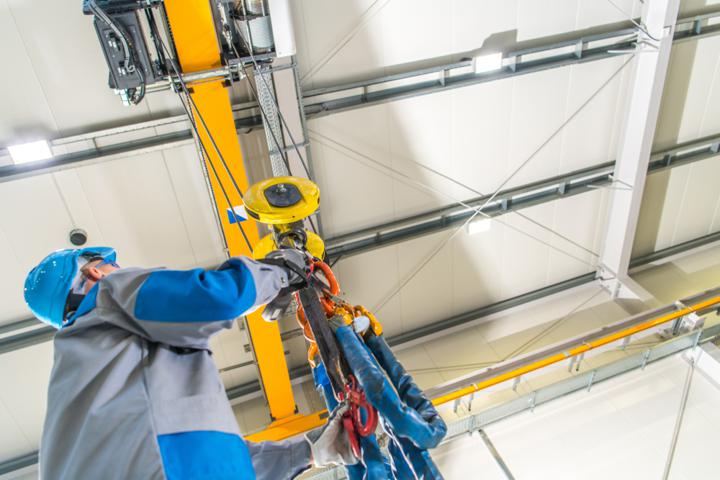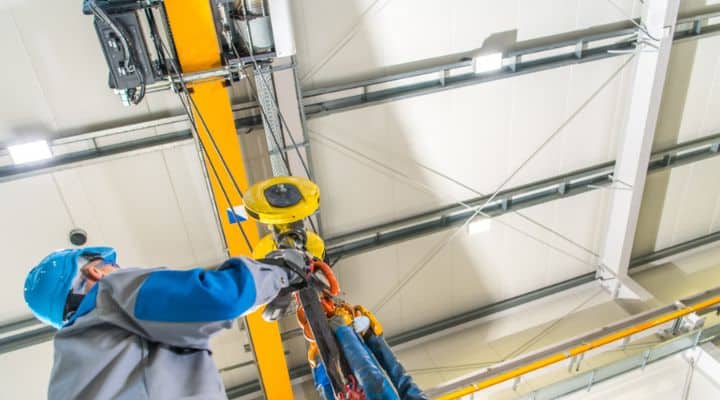Overhead Bridge Cranes: Single Girder and Double Girder Cranes
To the casual observer cranes look very much alike. Besides a girder crane, other members of the family include overhead cranes, single girder cranes, and double girder cranes. We also have the bridge cranes, double girder overhead crane, the single girder overhead crane, double girder crane, running bridge crane and that familiar name: the gantry crane. There are running cranes, the traveling cranes, as well as double girder traveling cranes.
In this group, we are concerned about strength and speed, power, reliability. Size is important because that usually relates to whether a crane is considered ‘heavy duty’. Can it pick a heavy load? How far out and hight, and at what weight? Is it equipped for material handling? What is its maintenance service schedule like, and how is a crane inspection performed in each case? Not all cranes are equal in size, speed and power.
All of those types of girder cranes have their own variations and considerations. They are all related, but each relative has its own, unique personality, strengths, and weaknesses. Realize that virtually all types of overhead cranes are variations of a girder overhead bridge crane.
While people seem able to identify a piece of equipment as relating to the crane family, they tend to get a bit lost after that. They do have questions when it comes right down to it. They want to know the proper name for the particular crane, what its primary use is, how it works, and what it can do. In this article we are going to cover the differences between a single-girder crane and a double-girder crane.
What is a crane girder?
A crane girder is a preformed metal beam on which the crab or hoist head of a traveling overhead crane runs. Such girders are typically “I” profile beams that may be reinforced at various points depending on the loads and crane configuration involved.
What is single girder overhead crane?
A single girder overhead crane is a type of bridge crane that consists of two or more overhead runways built into the building’s support structure, with the girder (the bridge) running between the runways for the width of the crane bay.

On a single girder crane, the bridge consists of one girder beam supported on each side by an end truck. The trolley and hoist are most commonly underhung—meaning they run on the bottom flange of the bridge. The bridge itself can either be top running or under running in design.
Single girder cranes offer better hook approach for both the trolley and the bridge travel than a double girder crane can.
One of the most common misconceptions about single girder cranes is that they are not as durable or of the same high quality as double girder cranes. If properly designed, a single girder crane can be the perfect solution for a business that needs a light to medium duty crane, or for a facility where headroom and/or floor space is limited.
Single girder bridge cranes are often the most cost-effective lifting solution for various applications and industries. Single girder cranes use less material and are more compact and lightweight than a double girder crane, which results in a significant cost-savings in material, freight, and installation. Also, because they only require one bridge beam, these systems typically have less deadweight, meaning they can utilize lighter runway systems and tie into the existing building support structure.
The major disadvantage of a single girder crane system is that they do have a limit in terms of capacity, span, and hook height. A double girder crane may be the better solution for overhead cranes that require capacities over 15 tons and spans over 65 feet.
Note: You will rarely see a single girder crane rated higher than 15-tons.
Advantages of a Single Girder Design:
- Less expensive due to a simpler trolley design, reduced freight costs, simplified and faster installation, and less material for the bridge and runway beams
- Most economical option for light to medium–duty cranes
- Lower loads on the building structure or foundations due to a reduced deadweight. In many cases, it can be supported by existing roof structure without the use of additional support columns.
- Better hook approach for both trolley travel and bridge travel
- Easier to install, service, and maintain
- Ideal for workshops, warehouses, material yards, and manufacturing and production facilities
- Lighter load on runway rails or beams means less wear on the beams and end truck wheels over time
- Great for facilities with low headroom
Double Girder Overhead Bridge Cranes
A double girder overhead crane is a lifting solution designed to carry medium and heavy duty loads. By using two adjacently positioned beams, double girder cranes offer improved support for the goods being handled, allowing the movement of larger capacities.
Double girder cranes can provide an extra 18-36″ of hook height because the trolley and hoist are placed between or on top of the cross girders.
On a double girder crane, there are two girder beams that make up the bridge and they’re supported by an end truck on each side. In most instances, the trolley and hoist run on a rail installed on top of the bridge girders. With a double girder design, you gain the depth of the cross girder if the hoist is placed between or on top of the cross girders—providing an extra 18”-36” of hook height in most cases.

Double girder cranes can be either top running or under running in design. A top running double girder bridge crane will provide the most overhead room, as well as the greatest hook height.
Double girder cranes are recommended for heavy-duty applications where the crane has to handle heavier capacities and longer spans. Because of this, the components of the crane system, including the hoist and trolley, are more complex in design—making double girder cranes more expensive than a single girder crane.
Advantages of a Double Girder Design
- Greater hook height – how far above the floor the hoist will lift (typically 18-36” more than single girder)
- No limits to maximum span or capacity
- Ideal for production and transportation of heavy equipment
- Ideal for frequent lifting of heavy loads
- Added features like walkways and maintenance platforms, cabs, magnetic reels, and lights can be added and supported by a double girder design
- Can be used in indoor and outdoor applications, including mining, iron and steel, rail yards, and ports
Disadvantages of a Double Girder Design
- More expensive because of added material costs, additional structural support, and more complex crane components
- Additional costs related to freight and the installation of the crane versus a single girder crane
- Hook approach is lessened for both trolley travel and bridge travel—especially on double girder top running cranes
Choosing Single Girder vs Double Girder
What are the pros and cons of single-girder and double-girder cranes, and which type is right for your application?
If lifting height is not a concern, and loads are light to medium weight, and use is not severe, a single girder design may work well and should be less expensive. Constant applications needing lifts over 15 tons and lifting height is a major concern, then a double girder design crane is in order.
Consider Installation and Maintenance
If you’re trying to decide between a single girder crane or a double girder crane for your project, consider getting a third party consultation with an expert like Crane Tech.
Because all crane systems are machines, they experience wear and must be maintained regularly and repaired quickly. As such, availability of parts and service is a critical consideration. Every crane system manufacturer can furnish and install the new equipment being sold, but they can’t give you an independent, unbiased consultation that considers all of the brands and factors. And very few can provide parts and emergency service for all brands.




